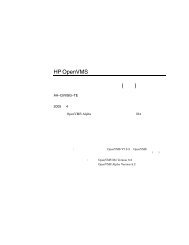HP ProCurve Wireless Access Point 420 - Hewlett Packard
HP ProCurve Wireless Access Point 420 - Hewlett Packard
HP ProCurve Wireless Access Point 420 - Hewlett Packard
You also want an ePaper? Increase the reach of your titles
YUMPU automatically turns print PDFs into web optimized ePapers that Google loves.
Example<br />
<strong>HP</strong><strong>420</strong>(if-wireless g)#max-association 32<br />
<strong>HP</strong><strong>420</strong>(if-wireless g)#<br />
multicast-cipher<br />
Command Line Reference<br />
Interface Commands<br />
This command defines the cipher algorithm used for broadcasting and multicasting<br />
when using Wi-Fi Protected <strong>Access</strong> (WPA) security.<br />
Syntax<br />
multicast-cipher <br />
• AES - Advanced Encryption Standard<br />
• TKIP - Temporal Key Integrity Protocol<br />
• WEP - Wired Equivalent Privacy<br />
Default Setting<br />
WEP<br />
Command Mode<br />
Interface Configuration (<strong>Wireless</strong>)<br />
Command Usage<br />
• WPA enables the access point to support different unicast encryption<br />
keys for each client. However, the global encryption key for multicast<br />
and broadcast traffic must be the same for all clients. This command<br />
sets the encryption type that is supported by all clients.<br />
• If any clients supported by the access point are not WPA enabled, the<br />
multicast-cipher algorithm must be set to WEP.<br />
• WEP is the first generation security protocol used to encrypt data<br />
crossing the wireless medium using a fairly short key. Communicating<br />
devices must use the same WEP key to encrypt and decrypt radio<br />
signals. WEP has many security flaws, and is not recommended for<br />
transmitting highly sensitive data.<br />
• TKIP provides data encryption enhancements including per-packet<br />
key hashing (i.e., changing the encryption key on each packet), a<br />
message integrity check, an extended initialization vector with<br />
sequencing rules, and a re-keying mechanism.<br />
TKIP defends against attacks on WEP in which the unencrypted<br />
initialization vector in encrypted packets is used to calculate the WEP<br />
key. TKIP changes the encryption key on each packet, and rotates not<br />
6-71

















